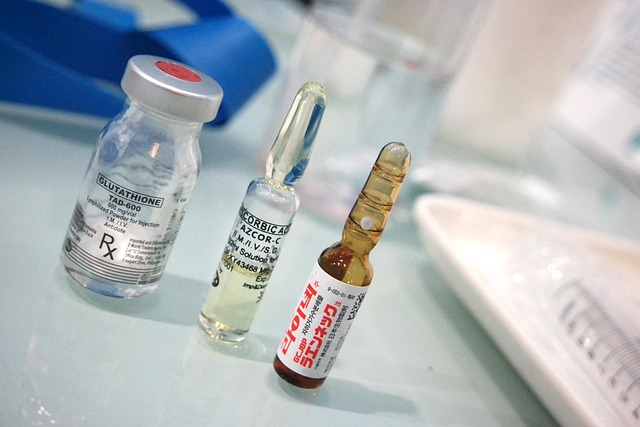The semaglutide injectable form, a key tool in managing blood glucose levels, requires precise storage and administration. It mimics natural gut hormones to slow digestion and curb appetite for weight management. Storage conditions must be cool (20°C-25°C/68°F-77°F), dry, protected from light, and within temperature limits to preserve potency. Proper handling techniques include aseptic environment, sterile equipment, tracking expiration dates, and site rotation to prevent reactions. Common mistakes like incorrect storage or administration can reduce effectiveness. Travel in warmer climates requires insulated bags. Consistency in routine is crucial for accurate dosing. Responsible disposal and recycling of used equipment are vital for public safety and environmental stewardship. FAQs offer tailored guidance on storage, handling, and common concerns.
“Discover the intricacies of managing semaglutide injections with our comprehensive guide. From understanding the unique properties of this injectable form to mastering storage and handling techniques, we demystify optimal practices. Learn about ideal storage conditions, common pitfalls to avoid, and how to navigate expiry dates. Additionally, explore special considerations for travel and tips for maintaining a regular dosing routine. Our resource also covers responsible disposal methods and answers frequently asked questions, ensuring you’re well-equipped to handle semaglutide injections safely and effectively.”
Understanding Semaglutide Injectable Form: A Comprehensive Overview

Semaglutide, a novel glucagon-like peptide-1 (GLP-1) receptor agonist, is delivered to the body via injectable form. Understanding this semaglutide injectable form is crucial for effective and safe administration. The injectable is typically a clear, colorless, or slightly cloudy solution that comes in prefilled syringes or vials. Each dose contains a precise amount of semaglutide, allowing for precise blood glucose control.
This medication works by mimicking the effects of natural hormones produced by the body’s gut, slowing digestion and reducing appetite, which can aid in weight management. Knowing how to handle and store this injectable form properly is essential. It should be stored in a cool, dry place, away from direct sunlight, and kept within the specified temperature range to maintain its potency. Users should also ensure proper technique when administering injections, including rotating injection sites to prevent lipoatrophy, and following storage instructions provided by the manufacturer.
Storage Conditions for Optimal Stability and Effectiveness

The proper storage conditions are critical for maintaining the stability and potency of semaglutide in its injectable form. This medication should be stored at controlled room temperature, typically between 20°C and 25°C (68°F to 77°F). Extreme temperatures, both high and low, can degrade the active pharmaceutical ingredient (API), leading to reduced efficacy. It’s important to protect semaglutide from direct sunlight and moisture as well; therefore, storing it in a cool, dry place is ideal. Additionally, keeping the vials or prefilled syringes in their original packaging helps maintain stability by preventing exposure to air and light.
When handling semaglutide injections, avoid repeated freezing and thawing cycles, as these can also compromise the integrity of the drug. If refrigerated storage is necessary for any reason, ensure a gradual temperature shift to minimize the risk of degradation. Always inspect the medication visually before each use; if it shows signs of discoloration, precipitation, or an unusual texture, it should be discarded. Following these storage guidelines ensures that semaglutide maintains its quality and remains effective when administered as prescribed.
Handling Techniques to Ensure Safety and Accuracy

Proper handling techniques are essential for storing and administering semaglutide injections, ensuring both safety and accuracy. When dealing with this specific medication in its injectable form, healthcare professionals should adhere to strict protocols. First and foremost, it’s crucial to maintain an aseptic environment throughout the process. This involves using sterile equipment, including syringes, needles, and containers, to prevent any contamination that could affect the potency of the drug.
Additionally, proper storage conditions are vital for preserving the effectiveness of semaglutide. The medication should be kept in a cool, dry place, typically between 2°C and 8°C, away from direct sunlight. It’s important to check the expiration date regularly and discard any unused or expired vials as per manufacturer guidelines. Accurate tracking and organization of these injections are key to maintaining quality control and ensuring patients receive the correct dose at the right time.
Common Mistakes to Avoid During Storage and Administration

When storing and handling semaglutide injections, there are several common mistakes that individuals make which can compromise the effectiveness of the medication. One of the primary errors is misstating the expiration date or neglecting to store it in a cool, dry place away from direct sunlight. The semaglutide injectable form is sensitive to temperature fluctuations and light exposure, so proper storage conditions are crucial to maintain its potency.
Another mistake to avoid is improper administration techniques. This includes using expired medication or injecting at the wrong site, which can lead to local reactions or systemic side effects. Always double-check the expiration date and ensure that you’re familiar with the correct injection technique as per medical guidance. Additionally, never share needles or vials of semaglutide with others to prevent contamination and infection.
Understanding Expiry Dates and Their Impact

Semaglutide injections, in their injectable form, require careful handling and storage to ensure optimal efficacy. Understanding expiry dates is a crucial aspect of this process. Each batch of semaglutide has a specific shelf life, typically indicated by a date on the packaging. This date signifies when the medication will no longer be effective if not stored properly. Expiry dates are set to guarantee that patients receive medicine within its peak performance window.
Ignorance or disregard for these dates can lead to reduced potency and potentially ineffective treatments. Proper storage involves maintaining recommended temperatures, usually between 2°C and 8°C (35°F and 46°F), in a cool, dry place, away from direct sunlight. If the expiry date is approached, consider using the medication promptly or consulting a healthcare provider for alternative options to minimize waste and ensure continuous treatment benefits.
Special Considerations for Travel and Outdoor Activities

When planning travel or outdoor adventures, especially to warmer climates, it’s essential to consider the specific storage requirements for semaglutide injections. As a medication delivered in an injectable form, maintaining proper temperature control is crucial for preserving its potency and effectiveness. During transit, ensure your cooler bag remains chilled with cold packs to mimic the refrigerated conditions recommended by pharmaceutical guidelines.
Outdoor activities might expose you to varying temperatures, so a well-insulated cool bag or pouch designed for medication storage can be a handy investment. This will help protect your semaglutide vials or pens from heat, ensuring they remain stable and ready for use at any time during your travels or adventures.
Tips for Maintaining a Consistent Dosing Schedule

Staying on track with your semaglutide injections is crucial for managing your health effectively. To ensure consistency in dosing, establish a regular routine and set reminders. Keep your semaglutide injectable form in a designated spot, easily accessible to help you remember each dose. Use a pill organizer or set alarms on your phone to notify you when it’s time for another injection.
Consider incorporating your injection schedule into daily activities for convenience. For example, you might choose to administer the medication right after waking up or before bedtime. Consistency is key, so aim to stick to this routine as closely as possible to maintain optimal blood sugar levels and avoid disruptions in your treatment plan.
Disposal Methods: Responsible Recycling of Used Injection Equipment

Proper disposal of used semaglutide injection equipment is crucial to ensure safety and environmental responsibility. Never dispose of used needles, syringes, or vials in regular trash as they pose a significant risk of injury and infection. Instead, seek out local guidelines for proper disposal methods, which often include specialized medical waste collection services. Many communities have drop-off locations at healthcare facilities or pharmacies where you can safely recycle these items.
Responsibly recycling semaglutide injectable forms helps to minimize environmental impact. The materials used in these devices, including plastic and metal, can be recovered and repurposed, reducing the demand for new production and lessening waste. Following proper disposal protocols not only protects public health but also contributes to a more sustainable future by promoting the responsible use of resources.
Frequently Asked Questions: Addressing Common Concerns

Frequently Asked Questions: Addressing Common Concerns
Many patients have questions about storing and handling their semaglutide injections, especially when transitioning from an oral medication. Understanding the proper care for this injectable form of semaglutide is key to ensuring its effectiveness and safety. One common query is how to store the medication at home. Typically, semaglutide should be kept in a cool, dry place, similar to many other medications. Avoid extreme temperatures and direct sunlight to maintain the integrity of the drug. It’s important to note that some products may have specific storage instructions, so always check with your pharmacist or healthcare provider for detailed guidance tailored to your particular brand.
Another frequent concern revolves around how long the medication remains viable after opening. While this can vary based on manufacturer recommendations, many semaglutide injectables offer a reasonable shelf life once the vial is accessed. Keep track of the date you open it and use the medication within the recommended timeframe. Discard any unused portions according to local waste disposal guidelines. If you have specific questions about dosage or potential interactions with other medications, don’t hesitate to consult your healthcare provider for personalized advice.
